
Home About Us Contact Us Subscribe

Home About Us Contact Us Subscribe
|
|
|
|
Architecture Parlante: The Darwin Centre by HOK International
London, UK: A modern building sensitive to its historic setting is designed to captivate and educate visitors who want to see millions of bottled zoological specimens and the scientists who study them. by Kristen Richards August 26, 2002 Designing a museum of any type is fraught with any number of
aesthetic and technological challenges. The challenges in designing a modern
museum and research center in a historic setting can be absolutely daunting. A
case in point is the Darwin
Centre Phase One, designed by the London office of HOK International. The
123,789-square-foot (11,148-square-meter) Centre is located behind The Natural
History Museum, one of London’s grandest Romanesque Revival buildings, designed
by Alfred Waterhouse and completed in 1880. It is also one of the world’s
leading research institutions, housing well over 70 million plant, animal, fossil, rock,
and, mineral specimens gathered over 400 years. Waterhouse’s landmarked masterpiece is richly detailed with images of animals and plants. The Darwin Centre uses contemporary detailing and construction techniques to recreate this historic tradition of “architecture parlante” (literally “talking architecture”) – buildings whose external appearance indicates the activities taking place inside. The zoomorphic brackets of the solar wall, the changing appearance created by the sun-tracking metal louvers, and the triple-skin, caterpillar-like inflated roof refer directly to the contents of the new facility: the museum’s vast collection of 22 million zoological specimens stored in spirit. (One indication of how massive the collection is: The Darwin Centre was completed December 2001 and opens to public on September 30 – the time needed to allow scientists and the specimens to be moved from old building.) The Darwin Centre Phase One meets a complex brief and demanding performance specifications without sacrificing elegance. It gives the public access to the collections that, until now, has never been possible to such an extent. "This is a dramatically new building type which provides the best curatorial laboratories and offices and encourages public access on a grand scale,” says HOK’s lead architect Guy Comely. "The design of the building allows visitors to sense the scale and order of the collection whilst scientists work above them in the privacy of dedicated suites of microscopy laboratories.” The building is comprised of three sections: in the front, behind the glass facade, are the offices and laboratories where scientists can be seen at work; at the back is the seven-story cold store for the specimens; separating the two is an atrium allowing the public entrée to the heart of the building. The contemporary all-glass façade is hung from 104 person-sized zoomorphic brackets specially designed for the Darwin Centre. Their rounded forms and organic styling recall the preserved specimens the building stores. The cast alloy steel supports are electroless nickel-plated giving them a matt metallic finish with warm ochre tones. They are bolted onto the structure of the building and have stainless-steel "spiders" that hold the glass in place. The “solar wall” has louvers sandwiched between two layers of glass. The louvers are computer-controlled to track the sun, giving the building an “intelligent skin” which changes constantly according to weather conditions and the time of day. As the sun warms the louvers they draw air up from ground level and out through a linear “chimney” at the top floor providing a highly efficient cooling mechanism. The louvered glass facade can be seen from busy Cromwell Road giving passersby an ever-changing view. Light filters down into the wedge-shaped atrium through the caterpillar-like roof – a Teflon "duvet" of ETFE (Ethyl Tetra Flouro Ethylene) inflated foil cushions. It is a transparent foil and should last for at least 30 years before being recycled and replaced. It is self-cleaning, anti-static, very strong, transparent to UV light, and is printed with dots (fritted) to reduce heat gain. The lightweight roof requires minimal structure to support it, and the layers of air make it thermally efficient. ETFE, also used for the Eden Project, is delivered in sheets, inflated on site, and is rigid when inflated to full pressure. The terracotta rain screen creates an architectural contrast to the transparency of the glass façade, and refers directly to the main Natural History Museum building. German manufacturer NBK produced a special batch with subtly modulated variations of color in a palette drawn from the original terracotta of the Waterhouse building. Inside, glass partitions allow guided tour groups to observe scientists at work in the laboratories from the atrium gallery walkways. Private offices are grouped at the southern end. Service spines remove the need for suspended ceilings allowing eight stories of work space within the building, whose height was subject to planning restrictions. Untreated concrete ceilings add to the bare industrial aesthetic of the building. From the floor of the public atrium the building’s organization is apparent. Occupied bridges containing libraries and breakout spaces cross between the cold store and the laboratories. Specimens can be seen being moved to the glass fronted laboratories in a transparent elevator, and floor-level glass panels offer views into the storage area. (Preserved specimens include sea creatures collected by Captain James Cook on his 1768 voyage to Australia and lizards brought back by Charles Darwin on his historic HMS Beagle expedition.) Careful consideration and cutting edge technology have been used to provide a controlled environment and avoid any potential hazards posed by the spirit used to preserve the collection. The entire seven-story storage area is chilled to below the flashpoint of the alcohol. Air ductwork to the collection contains gas detectors to sense whether there has been any spillage of alcohol. If vapor is detected, the mechanized plant switches to full-extract mode to dispel dangerous vapor harmlessly to the outside.
According to Brian Fishenden, HOK project manager for the Darwin Centre, architects, contractors and suppliers all excelled at meeting the unique challenges posed by the brief. "At first, the suppliers and contractors found it difficult to imagine how we could construct this rather unusual building. They had to invent new ways of doing things to solve problems that at first seemed insoluble," he says. "Take the curtain wall of glass in front of the labs and offices, for instance. The brief required a fully vapor-sealed system and this had never been dealt with in such great detail before. The design team lead the installers into developing the system to perform beyond levels that even the manufactures had envisaged." The HOK master plan for the Natural History Museum site
organizes life sciences to the western end and earth
sciences to the east. The completion of Phase One of the Darwin Centre is the
first stage in the complete re-modeling of the western end of the site which,
when finished, will form a life sciences center housing the zoology, botany,
and entomology collections. The Natural History Museum is currently
engaged in a fundraising campaign to raise the remaining funds to complete
Darwin Centre Phase Two, being designed by the Scandinavian firm C.F.Møller and Partners, which will house the museum’s 28 million
insects and six million plants. The
Darwin Centre Phase One Credits: Architect:
HOK International (London) Construction
contractors: Shepherd Construction Ltd Structural
MEP engineers: Buro Happold Façade
engineers: Arup Façade Engineering Project
management: Osprey Project Management Ltd Photography:
Peter
Durant/Arcblue.com HOK International Ltd. offers specialist skills to meet the needs of commercial developers, corporations, the hospitality industry, sport, and public institutions. With a staff of 250 in London, HOK is one of the largest architectural and interior design firms in Europe with emphasis on work in the commercial, corporate, and public sectors. HOK International Ltd is part of a global network of offices on four continents with staff of over 2,000 people serving clients by improving the built environment. |
(click on pictures to enlarge) 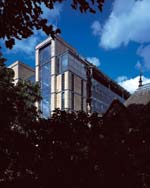 (Peter Durant/Arcblue.com) The Darwin Centre, view from Queensgate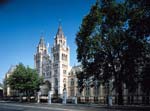 (Paul Ratigan) The stately Natural History Museum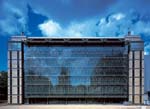 The glass façade of the south elevation The glass façade of the south elevation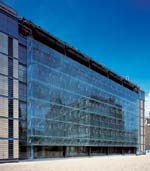 (Peter Durant/Arcblue.com) A closer view of the glass façade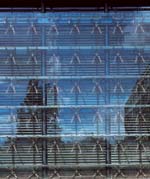 (Peter Durant/Arcblue.com) Zoomorphic (spider-like) brackets, as tall as a person, hold the glass to the façade. (HOK) A computer-generated version of the brackets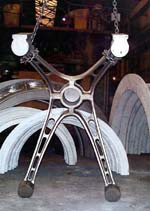 (HOK) A completed "spider" bracket still at the factory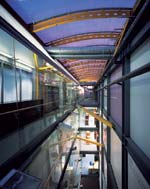 (Peter Durant/Arcblue.com) The atrium at dusk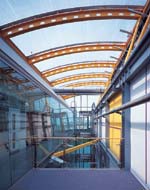 (Peter Durant/Arcblue.com) Natural light fills the atrium through a caterpillar-like roof - a Teflon "duvet" of ETFE (Ethyl Tetra Flouro Ethylene) inflated foil cushions.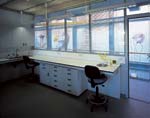 (Peter Durant/Arcblue.com) A typical laboratory has windows into the atrium.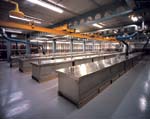 (Peter Durant/Arcblue.com) The tank room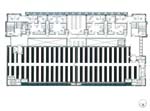 (HOK) Floor plan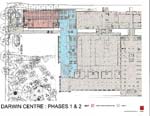 (HOK) Site plan (Brett Williams) Up on the roof: Guy Comely, lead architect, HOK International |
© 2002 ArchNewsNow.com